What to Pack for the Everest Base Camp Trek?
Are you planning a trek to Everest Base Camp in Nepal? To help you get ready, we have compiled the ultimate overarching packing list. A well-prepared packing list is essential for a smooth and enjoyable adventure. Choosing the right clothing, gear, and supplies will make all the difference in your trekking experience.
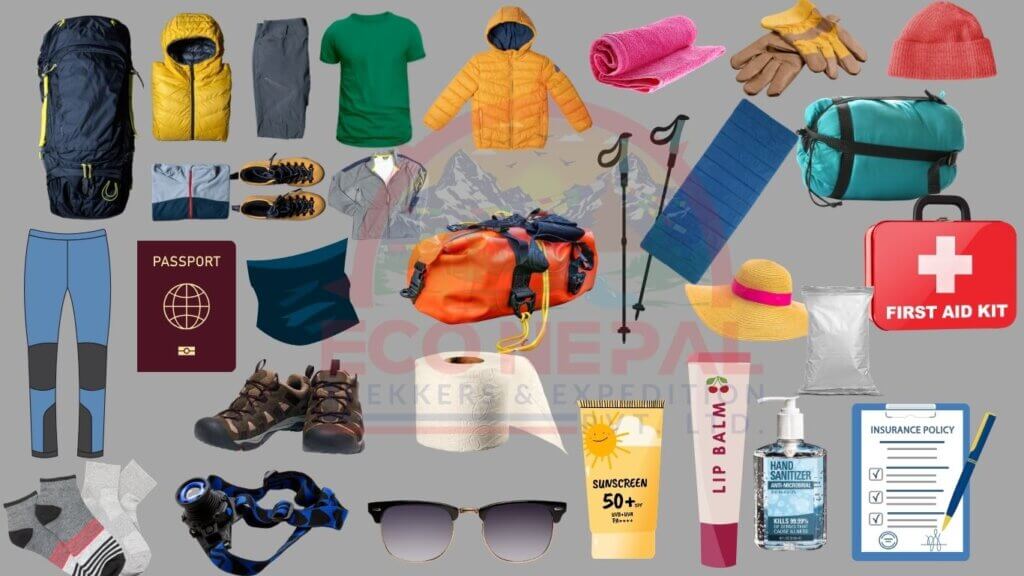
While packing for the Everest Base Camp Trek, it isn’t just about fitting gear into a bag; it’s a critical survival strategy that can either make or break your experience. Many first-time gliders underestimate how vital proper packing is until it’s too late. From Lukla to Everest Base Camp, you’ll be navigating high altitudes, freezing nights, unpredictable weather, and even natural calamities, where forgetting one essential item, such as water-purification tablets and other similar items, can lead to several consequences, like altitude sickness, dehydration, and early evacuation. So a meticulous packing system starts with your smart backpacking list.
For every item you pack, it should serve a purpose. You don’t need more; you need smart packaging. Packing for Everest Base Camp is not about fashion or extras; it’s about avoiding discomfort, injury, or even failure. Whether it’s layering correctly for a sudden snowstorm or pulling out an energy bar at 5,000 meters, your backpack is your lifeline. So, prepare with precision — because on Everest, you don’t pack to travel, you pack to endure.
Why is packaging crucial for the Everest Base Camp Trek?
Packaging for the Everest Base Camp Trek is mandatory for your preparation and can significantly impact your experience as a trekker on the trail. As a trekker, you need to have assurance of your precautions and safety. Guilders’ bestowing obligatory guidance, terms, and conditions are important, but your only survival probability remains in your hands, effort, and considering packages.
Packing is a critical aspect of the Everest Base Camp trek due to the extreme environmental conditions and limited resources available along the route. The trail from Lukla to EBC ranges in altitude from approximately 2,800 meters to 5,364 meters, leading to significant temperature fluctuations—from warm days to sub-zero nights. Proper layering, including thermal base layers and insulated outerwear, is essential for thermoregulation and preventing hypothermia. Additionally, the risk of altitude sickness increases with elevation, and dehydration is a common contributing factor. Therefore, packing water purification methods—such as tablets or filters—is vital, as untreated water sources may contain harmful pathogens that cause gastrointestinal illness.
Everest Base Camp Trek Gear
Many trekkers use the same packing approach for Nepal’s classic treks, such as Mardi Himal, Annapurna Circuit, or Manaslu, and while this works for those routes, there are no such packaging guidelines and policies for the trek. As guilders, they often pack unnecessary items such as fashionable jeans, accessories, formal clothing, and more. But on our Everest Base Camp Trek, we follow the necessary guidelines for backpacking items.
Headwear
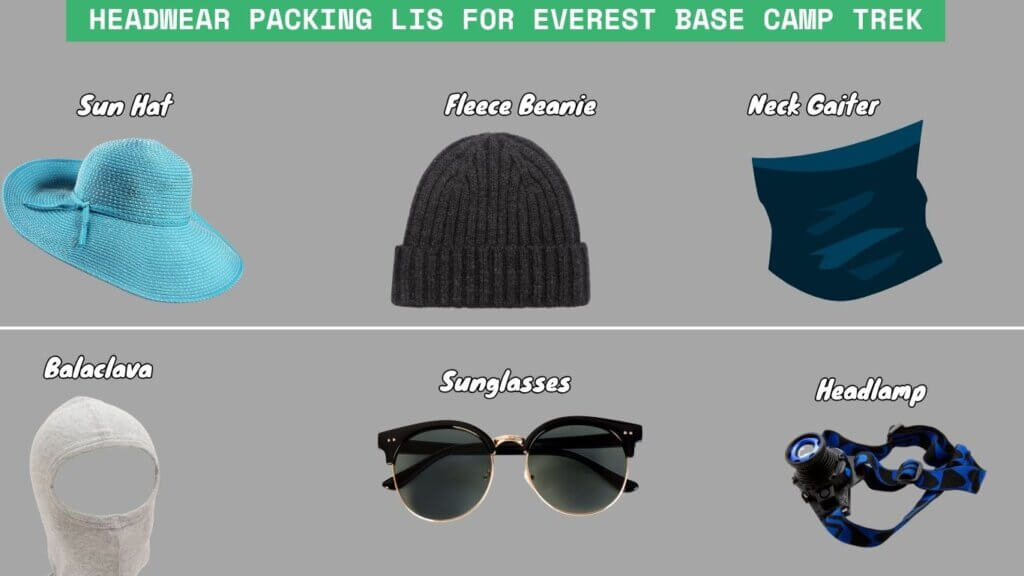
Headwear is an essential element to protect you from the intense sunburn during the day and the cold at higher altitudes. A collection of sun hats, wool beanies, and neck buffs ensures you’re prepared for both warmth and sun protection on your trek.
Sun Hat / Cap
It protects your face, ears, and neck from strong UV rays at high altitudes. A wide-brimmed sun hat is best for daytime hiking. It helps to prevent sunburn and heat exhaustion. Lightweight and foldable hat designs are great for trekking.
Wool or Fleece Beanie
It helps to keep your head warm in cold temperatures, especially during early mornings or evenings, and it helps to reduce body heat efficiently. So, you must have an item above 3,000 meters and pack breathable but insulating materials.
Neck Gaiter / Buff
It can be worn as a scarf, headband, or face cover, but also offers protection from dust, wind, and cold air, and is also useful for shielding your neck and mouth. So, lightweight and quick-drying neck gaiters/buffs are best for trekking.
Balaclava
It provides full-face coverage during wind, snow, or extreme cold, which is ideal for summit days or high passes and helps to retain warmth and prevent frostbite. It can also be layered with other headwear.
Sunglasses (UV Protected)
Reduces glare and protects your eyes from harmful UV rays that are essential at high altitudes due to intense sunlight and snow reflection. So choose polarized lenses with side shields to prevent you from snow blindness.
Headlamp / Beanie with Headlamp Slot
Essential for early morning treks or power outages in lodges. So bringing a bright LED headlamp ensures safety in the dark, and also look for rechargeable or long-battery options, and a bonus if it fits securely over a beanie perfectly.
Handwear
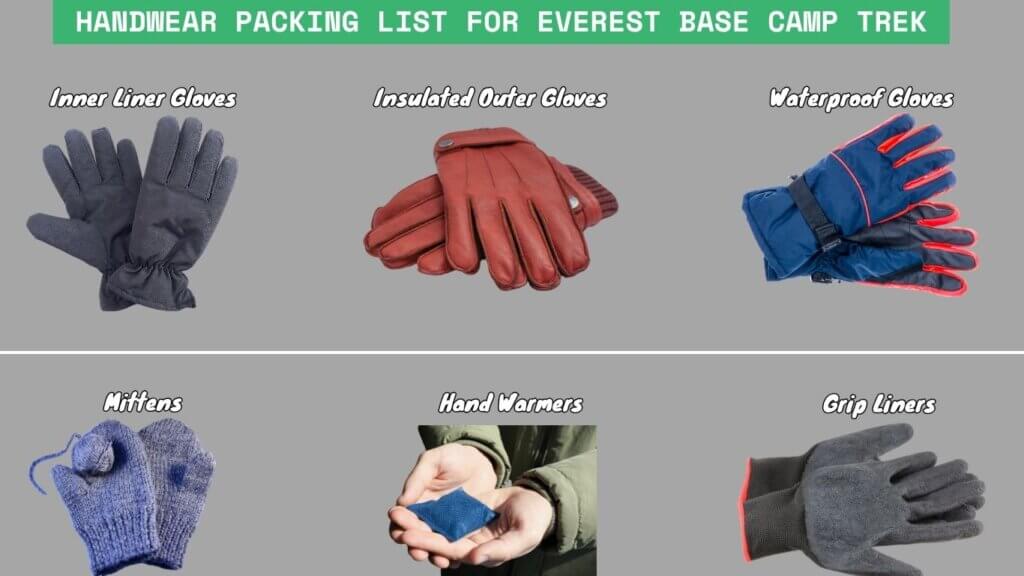
While trekking at high altitudes, your cold fingers can make trekking miserable. So, liner gloves, insulated main gloves, and waterproof outer shells are crucial to ensure your hands stay warm and dry throughout the hike, especially in windy or snowy conditions.
Inner Liner Gloves
This is lightweight and moisture-wicking, which is great for mild conditions as a base layer under warmer gloves. They offer dexterity and keep hands warm while trekking.
Insulated Outer Gloves
Thicker insulated outer gloves are for colder altitudes, especially during early starts or snowy days, and look for windproof and water-resistant materials with fleece or synthetic insulation.
Waterproof Gloves or Shell Mitts
It needs to be worn over other gloves, so that they protect against snow, rain, and cold wind, and are essential for staying dry and warm in extreme conditions.
Mittens
It is warmer than gloves, and also traps heat more effectively. They are great for very cold mornings or summit days, though they reduce finger movement.
Grip Liners
They are thin gloves with grip, which is ideal for using trekking poles or gear, and are also comfortable in cool weather or under outer gloves.
Hand Warmers
It is single-use or rechargeable and provides extra heat in freezing conditions, which is helpful for those sensitive to cold or in emergencies.
Upper BodyWear
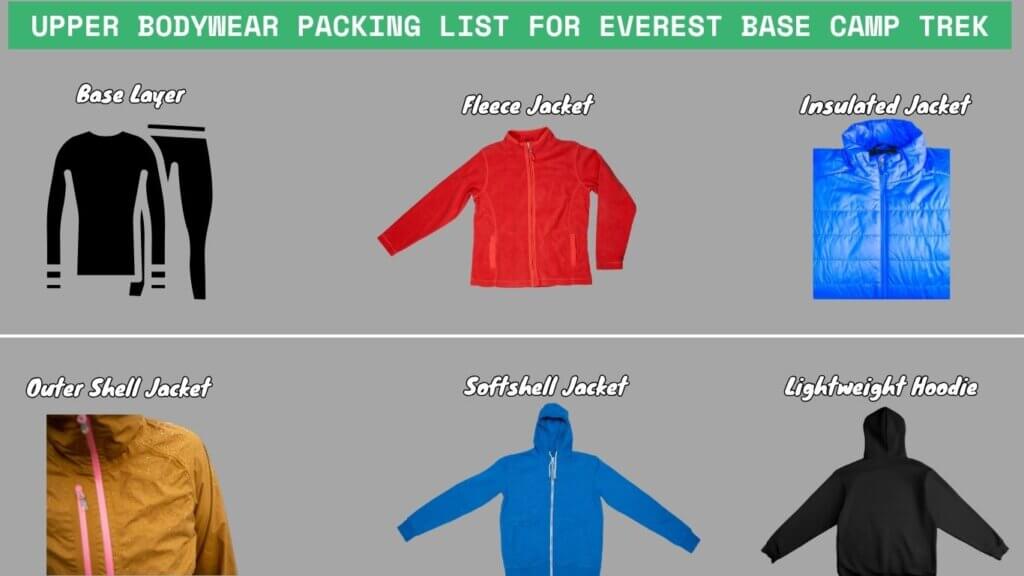
For upper bodywear, layering is key in the Himalayas. It starts with moisture-wicking base layers, adds insulation with a fleece or down jacket, and tops it off with a waterproof shell. This system lets you adapt easily to changing weather and elevation.
Base Layer (Thermal or Merino Top)
This layer is worn directly on the skin, which wicks away sweat and keeps you dry during the trek. So, merino wool or synthetic materials are best for warmth and odor control.
Mid Layer (Fleece Jacket or Lightweight Down)
It provides insulation and traps body heat, which is ideal for chilly mornings or when the temperature drops, especially above 3,000 meters.
Insulated Jacket (Down or Synthetic)
They are crucial for high-altitude cold. This jacket offers warmth during rest stops, evenings, or summit pushes., Down is lighter, and synthetic handles moisture better.
Outer Shell Jacket (Windproof/Waterproof)
It protects trekkers against wind, rain, and snow, whereas a good shell is breathable, lightweight, and fits over all other layers.
Softshell Jacket
They are great for dry but windy days, and offer mobility and light weather resistance, which is not as protective as a hard shell, but more breathable.
Lightweight Hoodie or Windbreaker
It is useful during early trekking hours or windy sections, as it packs small and adds an extra layer of comfort without bulk.
Lower Body Layers
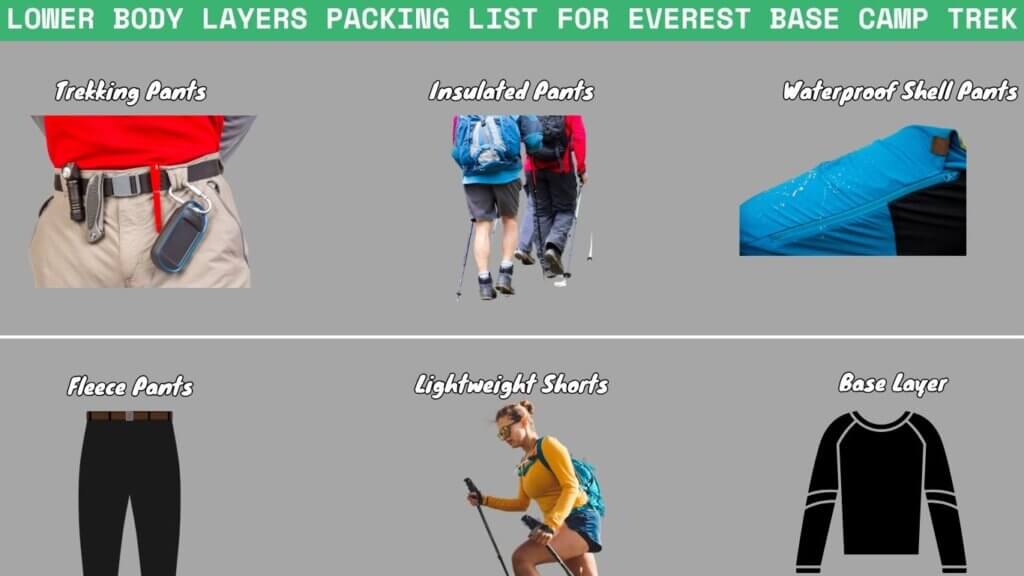
Your legs need to stay dry, warm, and flexible while reaching high altitudes. So, trekking pants, thermal leggings, and rain shells together provide you the right comfort and protection, whether you’re crossing dry valleys or snowy paths.
Base Layer (Thermal or Merino Bottoms)
These are worn under your trekking pants in cold weather to retain warmth. So you must choose moisture-wicking and breathable materials like merino wool or synthetic thermal layers.
Trekking Pants
They are durable, quick-drying pants for everyday hiking, often renowned as Convertible pants (zip-off) that help change temperatures during the day.
Insulated Pants
It is used at higher altitudes or during very cold days, in which down or synthetic-insulated pants provide extra warmth at camp or during rest stops.
Waterproof Shell Pants
This is essential for rainy or snowy conditions, worn over trekking pants to block wind and moisture while staying breathable.
Fleece Pants
Best for evenings or sleeping at colder altitudes, and are also soft, cozy, and warm – perfect for post-trek comfort in teahouses.
Lightweight Shorts
Very handy during lower-altitude days or hot afternoon hikes. So choose breathable fabrics that dry quickly.
Footwear
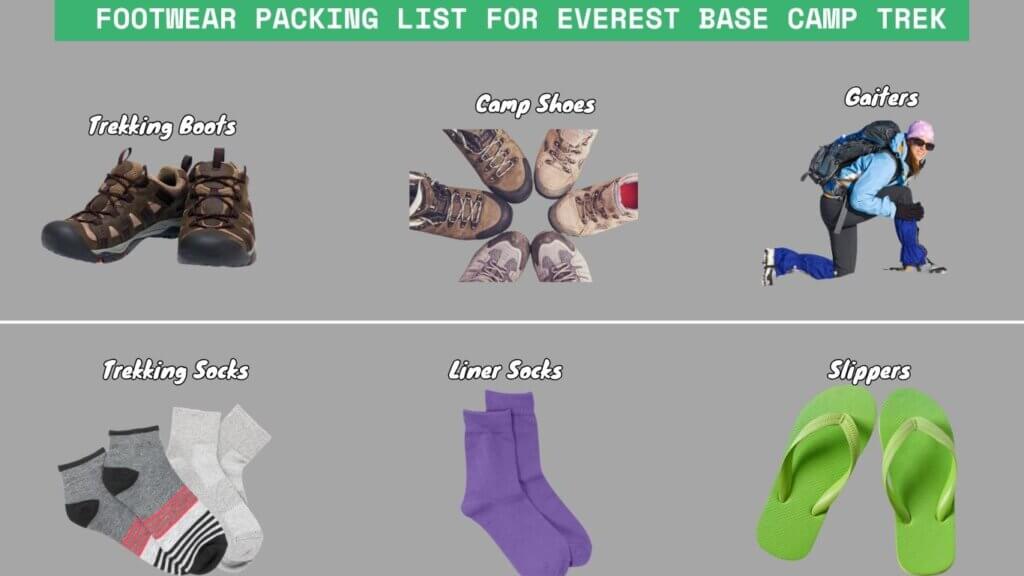
Durable boots are your best friend on this trek. So consider bringing reliable waterproof trekking boots, proper socks, and gaiters to keep your feet warm, dry, and blister-free across rough and unpredictable terrain during trekking at Everest Base Camp..
Trekking Boots
Sturdy, high-ankle boots provide grip and ankle support on rough terrain. So, make sure they’re well broken-in, waterproof, and designed for long hikes.
Camp Shoes (Slippers or Sandals)
They are lightweight and easy to slip on, perfect for resting your feet at teahouses after a day of trekking, and also come in handy for bathroom trips or short walks.
Gaiters
It covers the tops of your boots and lower pants to keep out snow, mud, or debris, and is especially useful in snowy or muddy sections of the trail.
Trekking Socks (Wool or Synthetic)
The moisture-wicking and cushioned socks keep feet warm and blister-free, by carrying multiple pairs to rotate and keep feet dryable, woolen trekking socks are necessary.
Liner Socks
These thin socks are worn under trekking socks to reduce friction and prevent blisters, which also helps to manage moisture more effectively.
Down Booties
Insulated booties are essential for keeping your feet warm inside lodges or sleeping bags at high altitudes. Lightweight and packable, they’re a cozy comfort item.
Everest Base Camp Toiletries: The Ultimate Lightweight Hygiene Kit
Prioritizing personal hygiene during the Everest Base Camp (EBC) trek is essential for health, comfort, and preventing illness—especially when facilities are limited, and due to cold temperatures, shared bathrooms, and lack of running hot water at higher altitudes, trekkers must rely on lightweight, compact, and water-efficient toiletries. So, a proper hygiene kit will keep you fresh and also prevent you from gastrointestinal illness, skin infections, and altitude-related complications that can be worsened by poor health and sanitation.
Thereafter, carrying too many items also adds unnecessary weight, so it’s crucial to pack smart and prioritize multi-use, biodegradable products. Toiletries at teahouses are expensive and often unavailable, especially above Namche Bazaar, making your own hygiene kit even more important.
Essential Toiletries You Must Pack for the Everest Base Camp Trek
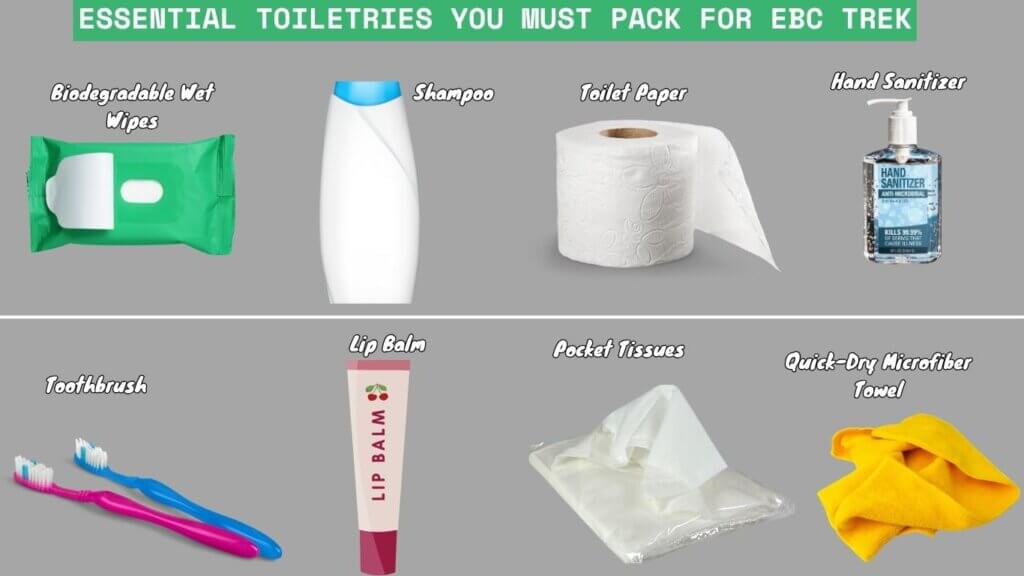
Biodegradable Wet Wipes
These are crucial for body cleaning when hot showers are unavailable at high altitudes, which helps to prevent body odor, rashes, and bacterial buildup. So carrying 1–2 travel-size packs is crucial for your own hygiene at alpine altitude.
Biodegradable Soap & Shampoo
They are needed for eco-friendly washing in areas with limited water, which prevents pollution in Himalayan streams and supports basic hygiene. Carrying one small bottle each helps you maintain your health and cleanliness.
Toilet Paper (or Compressed Tissue Rolls)
It is not provided in teahouses, but they are essential for personal hygiene and trail toilet breaks. Bringing two rolls or equivalent compressed tissues will be enough for an elevated altitude.
Hand Sanitizer (at least 60% alcohol)
This prevents foodborne and bacterial illnesses due to poor handwashing access, and is vital at higher altitudes where illness spreads quickly. Packing one 50–100 ml bottle is enough for your sanitation.
Toothbrush and Travel-Size Toothpaste
These are necessary for oral hygiene in cold, dry climates that increase gum issues. So packing one toothbrush and one small toothpaste helps you to clean your teeth, reducing the risk of infection at higher altitudes.
Lip Balm with SPF
It prevents cracked, sunburned lips caused by intense UV rays and dry winds. Hence, carrying one stick (SPF 30+) lip gloss and balm is essential for protection and comfort.
Quick-Dry Microfiber Towel
The regular towels stay wet and are heavy, and also, microfiber towels dry fast and prevent odor. So packing 1 small-medium towel will be ideal for face and hand drying.
Nail Clipper and Tweezers
It helps you to prevent infections from dirt under nails and remove blisters/splinters. These are basic tools, but essential to maintain your hygiene at elevated altitudes.
Pocket Tissues/Face Wipes
They are useful for runny noses, trail toilet needs, or face cleaning in cold conditions. Carrying 5–7 pocket-sized packs also helps you to drain sweat and is essential for other toiletries.
Feminine Hygiene Products
Generally, for females, menstrual cups (1) or sanitary pads/tampons (10–15) are necessary due to a lack of proper disposal options, and must be packed out for one’s own responsibility.
Essential Tech Gear for Everest Base Camp Trekking 2025/2026
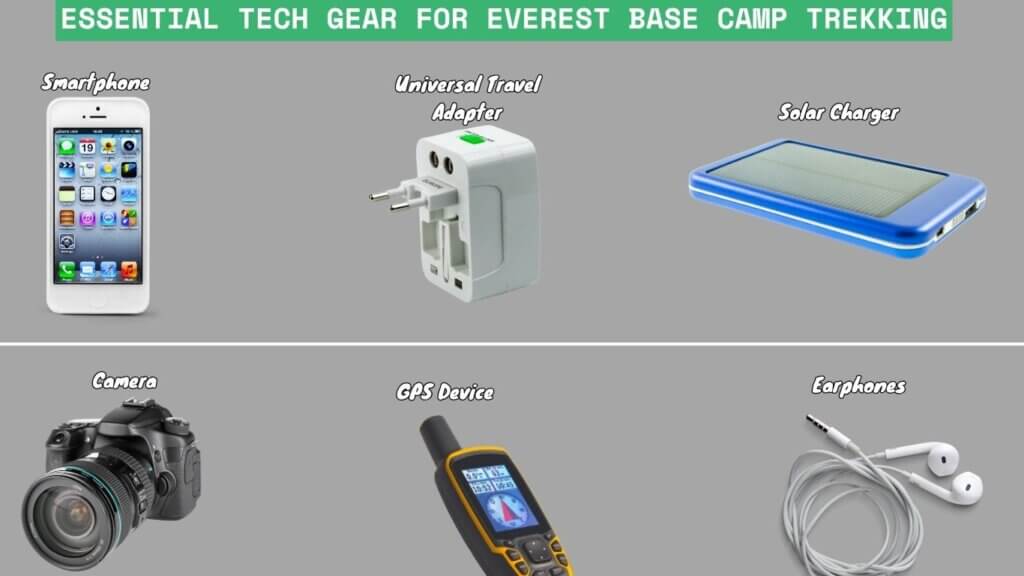
While trekking to Everest Base Camp, reliable tech gear is essential for safety, communication, and preserving memories in a harsh alpine environment. Key items include backup power sources like power banks and solar chargers, headlamps with extra batteries for visibility, smartphones with offline maps and GPS, universal adapters for efficient charging, cameras or action cams for capturing stunning views, and portable water purifiers to prevent waterborne illnesses. Proper tech preparation enhances the safety and enjoyment of the trek.
Smartphone with Extra Power Bank
Your smartphone is critical for communication, GPS navigation, weather updates, and photography. So, carry a high-capacity power bank (10,000mAh or more) as electricity can be unreliable at higher elevations.
Universal Travel Adapter
Nepal uses Type D, C, and M sockets with a 230V supply. Packing a universal adapter ensures you can charge all your devices at teahouses without issues.
Headlamp with Extra Batteries
It is essential for trekking early mornings, late evenings, or in poorly lit tea houses, and a headlamp also frees your hands and is more reliable than phone flashlights in cold weather. Bring extra batteries for 15 days.
Solar Charger
They are useful for charging small devices in remote areas without power. So this trek has many sunny days, making solar power a sustainable backup.
Camera or GoPro
To capture the breathtaking Himalayan scenery and memorable moments, ensure extra memory cards and batteries, as cold drains battery life faster.
Portable Water Purifier (UV or Filter Type)
The tech-based water purification helps to avoid gastrointestinal illnesses common from untreated water sources on the trek.
Power Strip/USB Hub
Since outlets at teahouses are limited and often shared, a small power strip or USB hub will allow you to charge multiple devices simultaneously.
GPS Device or Offline Map App
The GPS devices or offline maps on your phone ensure safe navigation even if you’re about to lose cellular signal on the trail.
Earphones or Noise-Canceling Headphones
These are useful for entertainment and blocking out noise in crowded or noisy lodges, helping you rest better at the teahouses, tents, and on camp.
What to Include in Your Everest Base Camp Trek First Aid Kit
To ensure your trek is safe and comfortable, a well-prepared first aid kit is a must and critical for the Everest Base Camp trek due to the remote location, extreme weather, and high altitude challenges. So, limiting medical facilities along the trail and the risk of altitude sickness, blisters, and common trekking injuries means that you must carry essential medical supplies to manage minor ailments and emergencies, but packing the right first aid items will prevent small issues from becoming serious problems, ensuring a safer and more comfortable trek.
Everest Base Camp Trek Essential First Aid Kit List
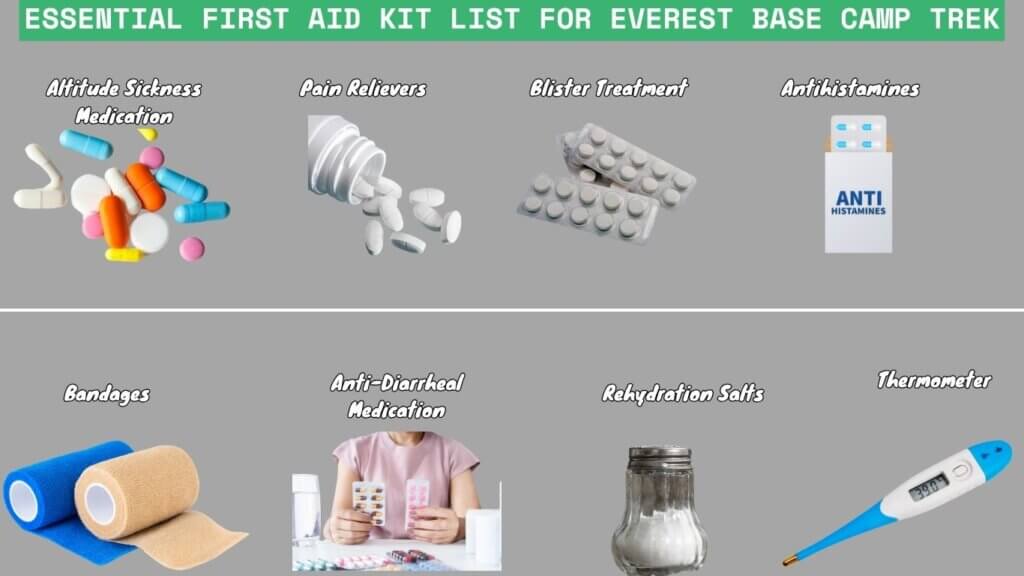
Altitude Sickness Medication
It helps to prevent and reduce symptoms of Acute Mountain Sickness (AMS), which also affects many trekkers above sea level.
Pain Relievers
They are effective for headaches, muscle pain, and fever, which commonly occur at alpine altitudes.
Blister Treatment
It also prevents infection and eases pain from blisters caused by long hours of walking and ill-fitting boots.
Bandages and Adhesive Plasters
They are essential for covering cuts, scrapes, and minor wounds to avoid infections while trekking at the Everest Base Camp Trek.
Antiseptic Wipes and Cream
It also helps to clean wounds and prevent infections in unsanitary conditions near teahouses, tents, and rooms.
Anti-Diarrheal Medication
It helps to prevent diarrhea caused by contaminated food or water, which can quickly lead to dehydration.
Rehydration Salts
They are crucial to maintain electrolyte balance and hydration in case of diarrhea or altitude sickness at an elevated altitude.
Antihistamines
These are useful for allergic reactions or insect bites commonly occurring in contaminated and unsanitary places.
Thermometer
It is used to monitor fever, which could indicate infection or altitude-related illnesses.
Tweezers and Small Scissors
They are used for removing splinters or cutting bandages, and are also used for crafting and cutting other materials.
Other Essential Gear for Everest Base Camp Trek
Trekking Poles
It provides crucial stability and reduces shear on knees at steep ascents and descents, improving endurance on harsh Himalayan trails.
Travel Towel
This lightweight, quick-dry travel towel is important for maintaining hygiene in teahouses as drying conditions will be slow due to cold and humidity on the elevated trail.
Two One-Litre Water Bottles
Carrying two 1-litre bottles prevents adequate hydration throughout the trek, as safe drinking water sources are limited and alpine altitude increases fluid loss.
Metal SIGG Bottle
A durable metal bottle can be filled with hot water at tea houses, which helps to warm your body temperature at night during trekking at high altitudes.
Water Purification System (Tablets or Filters)
Devices like Lifestraw or SteriPEN are essential for treating water and preventing waterborne illnesses common on the trail that occur through unpurified and contaminated water.
Crampons or Traction Spikes
For especially winter treks (November to March), crampons or chained spikes are necessary to enhance safety on icy or snowy paths, especially if boots lack built-in crampon compatibility on the trail.
Daypack with Rain Cover
A waterproof day pack protects your essentials from sudden rain and snow, keeping gear dry, accessible during daily hikes, and also prevents intense sunburn on the trek.
Rucksack or Duffel Bag
A sturdy duffel bag is also ideal for porters to carry your overnight gear, with 65 liters being the recommended size for your most EBC treks, considering porters’ health and hygiene.
Weight Limits for Everest Base Camp: Why Less is More and Safer?
When preparing for the Everest Base Camp trek, strategic packing is essential for both necessity and safety, as operators impose weight limits of 10-15 kg on duffel bags to protect porter welfare. Baggage allowances are also strict for flights from Kathmandu to Lukla (10 kg checked + 5 kg carry-on), with every extra kilo affecting both porter safety and your comfort. To streamline your load, prioritize versatile, lightweight gear and utilize secure luggage storage options in Kathmandu for non-trek items. Remember, less weight leads to greater mobility, safety, and respect for the porters who facilitate your journey.
Everest Base Camp Trek Gear Packing by Season: What to Bring for Spring, Autumn, Winter & Monsoon?
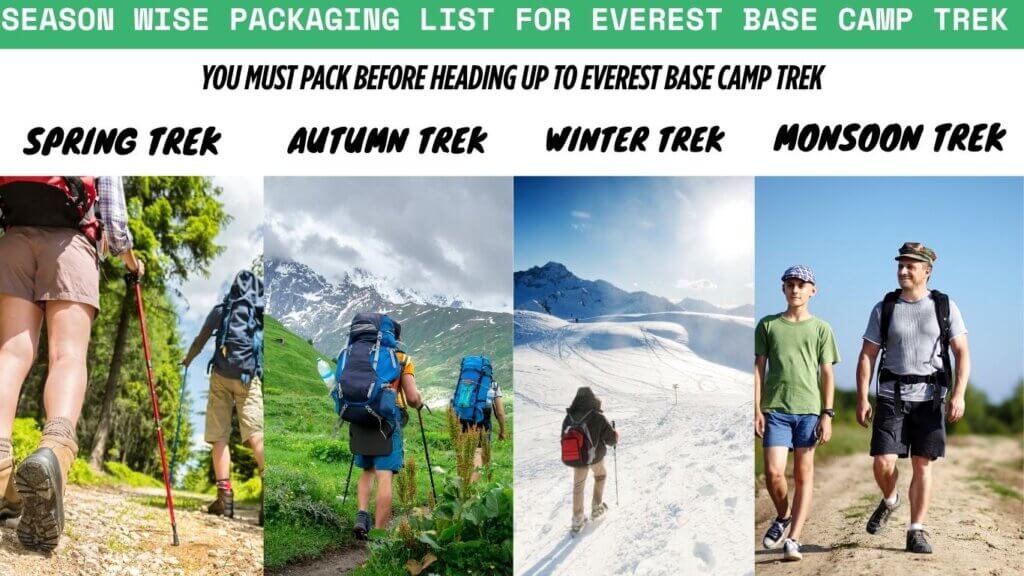
Our trekking experts have crafted the ultimate Everest Base Camp packing list, combining local wisdom with modern gear essentials to prepare you for the mountain’s unpredictable weather conditions and unlike generic lists, we reveal what Nepali guides actually carry, and also give guidelines on how to optimize your duffel and daypack for different seasons (spring, autumn, winter and monsoon), and which are the must have items to pack for the high altitude trail.
Spring (March-May)
Spring is the best season for Everest Base Camp trekking, with clear skies, stable weather, and moderate temperatures averaging 5°C to 15°C (41°F to 59°F), and also the trails burst with blooming rhododendrons, and trekkers can spot Himalayan Monals, Nepal’s national birds, and can also see locals harvesting rare herbs like Cordyceps sinensis.
With the snow melted on lower paths, trail conditions are safer and more comfortable, visibility of Himalayan peaks is excellent, teahouses are fully open, and crowds are manageable, offering both serenity and a social trekking atmosphere.
Essential Items You Must Pack for the Spring Season in the EBC Trek
- You must pack a high-quality insulated jacket to stay warm during the freezing nights and early mornings at higher altitudes.
- Thermal base layers are essential to maintain your core body heat and wick away sweat in cold spring conditions.
- A waterproof and windproof shell jacket and pants are necessary to protect yourself from sudden rain, snow, and harsh winds.
- Wearing sturdy, waterproof trekking boots is critical for foot protection and stability on rough and slippery mountain trails.
- A sleeping bag rated to at least -10°C is a must for surviving the cold nights in unheated tea house accommodations.
- You also need to carry water purification tablets and a reliable filter to ensure safe drinking water, avoiding gastrointestinal illness.
- The UV-protected sunglasses and high-SPF sunscreen are also crucial to shield your eyes and skin from strong ultraviolet rays at high altitude.
Autumn (Sept-Nov)
Autumn is an ideal season for trekking to Everest Base Camp, characterized by stable weather, clear skies, and moderate temperatures between 5°C and 18°C (41°F to 64°F). Following the monsoon, trails are clean, the landscape transitions to autumn colors, and mountain views are stunning with minimal haze. Although the weather is generally dry, early snowfall may occur at higher elevations, leading to fully operational teahouses and less crowded trails compared to spring. This provides a peaceful trekking experience, but nights can be cold, making proper layering and warm gear essential.
Essential Items You Must Pack for the Autumn Season for the EBC Trek
- A warm, insulated jacket is the most essential item for the body layer to stay protected from the cold mornings and chilly nights, especially above Namche Bazaar.
- Thermal base layers are essential for keeping your body warm and dry as temperatures drop at higher altitudes during late evenings on the uphill trek.
- Wearing waterproof and breathable trekking boots is crucial for foot comfort and protection on rocky and occasionally slippery trails.
- A sleeping bag rated to at least -10°C is necessary for maintaining warmth during cold nights in unheated tea houses
- You need a waterproof and windproof outer shell to shield yourself from sudden winds and occasional post-monsoon showers.
- The UV-protected sunglasses and high-SPF sunscreen are also a must-pack item, which helps you to prevent sunburn and eye strain from strong UV rays on higher altitude trails.
- A reusable water bottle with purification tablets and a portable water filter is essential for safe hydration and also to prevent diseases like diarrhoea and cholera during the trek.
Winter (Dec-Feb)
When trekking in winter, it is the most challenging season to trek on Everest Base Camp trek, temperatures often dropping below -20°C (-4°F) at higher altitudes such as Lobuche and Gorak Shep, that includes harsh weather conditions such as blizzards, heavy snowfall, and icy trails which can make your journey very risky and only suitable for experienced and well-prepared trekkers, with also to extreme cold and limited daylight hours, physical and mental endurance becomes critical.
Many tea houses at higher elevations may be closed or operate minimally, reducing access to food, shelter, and emergency aid, causing altitude-related illnesses that are more difficult to manage in winter as the body requires more energy to stay warm, increasing dehydration and fatigue. Hence, the trail visibility becomes poor due to snow cover, and icy sections pose a high risk of slipping injuries.
Even with such risks, winter offers unmatched solitude, crystal-clear mountain views, and a raw, silent Himalayan wilderness that is ideal for seasoned mountaineers looking for a serious alpine experience.
Essential Items you must pack for the Winter season for the EBC Trek
- A heavy-duty down jacket helps to protect you from extreme cold and icy winds above 4,000 meters.
- The expedition-based thermal base layers are also essential for maintaining body heat and preventing hypothermia in cold temperatures.
- Wearing double-insulated waterproof trekking or mountaineering boots is very critical to keep your feet warm and safe from frostbite and numbness.
- A sleeping bag rated to at least -20°C is necessary to survive bitterly cold nights in unheated or minimally heated lodges.
- You need crampons or microspikes to provide traction and prevent slipping on icy trails.
- Carrying hand warmers and insulated gloves is vital to keep your hands warm and avoid frostnip or frostbite.
- UV-protected snow goggles or glacier sunglasses are indispensable to protect your eyes from snow blindness caused by intense sunlight reflecting off snow.
Monsoon (June-Aug)
Monsoon is the least favorable season for Everest Base Camp trekking due to heavy rainfall, slippery trails, and increased risk of landslides in lower elevations. Temperatures range between 8°C and 18°C (46°F to 64°F), but high humidity and daily downpours make trekking physically demanding and uncomfortable. Cloud cover often obstructs mountain views, limiting visibility of the peaks. However, the lush greenery, blooming alpine flora, and fewer crowds can appeal to off-season trekkers seeking solitude. Flight delays or cancellations to and from Lukla are common due to poor weather conditions, so flexible travel plans are necessary. While possible, EBC trekking in the monsoon is only recommended for experienced hikers with a high tolerance for wet, muddy, and unpredictable conditions.
Essential Items you must pack for the Monsoon season for the EBC Trek
- You must pack a high-quality waterproof rain jacket and pants to stay dry during frequent and heavy monsoon downpours.
- Quick-drying, moisture-wicking base layers are crucial for keeping your body dry and comfortable in constantly humid and wet conditions.
- A Gore-Tex or similarly waterproof trekking backpack cover is necessary to protect your gear from soaking rain while on the trail.
- Waterproof trekking boots with a strong grip are essential to prevent slips on muddy, uneven, and leech-prone trails.
- You need to carry multiple pairs of quick-drying socks and innerwear to maintain hygiene and avoid fungal infections caused by prolonged dampness.
- Insect repellent and anti-leech protection (such as leech socks, cream, or salt) are vital for trekking through wet, forested areas below 3,000 meters.
- A reliable water purification method, like tablets or a portable filter, is critical as natural water sources may be contaminated by runoff.
Conclusion
Packing well for the Everest Base Camp trek is vital for safety, comfort, and overall success. From choosing the right clothing and footwear tailored to the specific season—whether spring, autumn, or winter—to assembling a lightweight yet comprehensive toiletries kit, each item plays a crucial role in your journey. Proper first aid supplies are essential to manage common trek-related issues such as altitude sickness, blisters, and minor injuries, while tech gear like headlamps, power banks, and GPS devices ensures you stay connected and safe in remote areas.
Keeping your pack within recommended weight limits—usually between 12 and 15 kg—helps maintain stamina and reduces risk on steep and rugged trails. Remember, carrying less but smarter is key in the high-altitude environment where every extra kilogram matters.
By carefully following a season-specific packing list and preparing for changing weather and terrain, you increase your chances of a comfortable, enjoyable trek. This guide is designed to help you cover all bases, from essentials to extras, ensuring you’re ready for the incredible adventure ahead at Everest Base Camp.
Pack smart, stay safe, and enjoy one of the world’s most breathtaking trekking experiences with confidence.
FAQS about Everest Base Camp Trek Packing List
What to bring for the Everest Base Camp trek?
Bring essentials for cold weather, high altitude, and long days of hiking. Key items include: Trekking boots, Warm down jacket, Sleeping bag (rated -10°C or better), Base layers, mid-layers, outer shell, Daypack & duffel bag, Trekking poles, Headlamp, Reusable water bottle + purification tablets, Personal medications and first aid for the trek.
What to wear for Everest Base Camp?
Layering is key. A standard daily setup: Base layer: moisture-wicking thermals, Mid-layer: fleece or softshell jacket, Outer layer: insulated down jacket + waterproof shell, Bottoms: trekking pants, thermal leggings if cold, Accessories: gloves, warm hat, buff, sunglasses. Adjust layers based on altitude and time of day.
What is the best bag for Everest Base Camp?
- Main bag (Duffel, ~60L): Carried by porter, rugged and waterproof
- Daypack (25–35L): Carried by you, with hip belt, hydration access, and rain cover
Look for brands like Osprey, Deuter, or North Face for durable options.
How do I prepare myself for Everest Base Camp?
Start training 2–3 months before:
- Hike/walk 4–6 hrs with elevation gain weekly
- Stair climbing and cardio workouts
- Train with a loaded backpack
- Practice hikes in boots you’ll wear
- Include altitude exposure if possible (acclimatization hikes)
How many pairs of socks for Everest Base Camp?
Bring 4–5 pairs of wool or synthetic hiking socks and two liner socks. Wash and rotate them. Avoid cotton—retains moisture and causes blisters.
What sleeping bag for Everest Base Camp?
A four-season sleeping bag rated to at least -10°C (comfort) or -15°C (extreme). Down-filled is warmer and lighter. Examples:
- North Face Inferno -20°F
- Marmot Col -20
- Or rent a bag in Kathmandu (verify cleanliness and condition)
What kind of jacket for Everest Base Camp?
- Insulated Down Jacket (800-fill or better; packable and warm)
- Waterproof/Windproof Shell Jacket (Gore-Tex preferred)
- Optional: lightweight fleece or softshell for daytime hikes
What gloves do you need for Everest Base Camp?
- Thin liner gloves (for hiking)
- Insulated gloves or mittens (for mornings/nights)
- Windproof outer gloves (optional for high altitudes)
Water-resistant materials help in snow or rain

